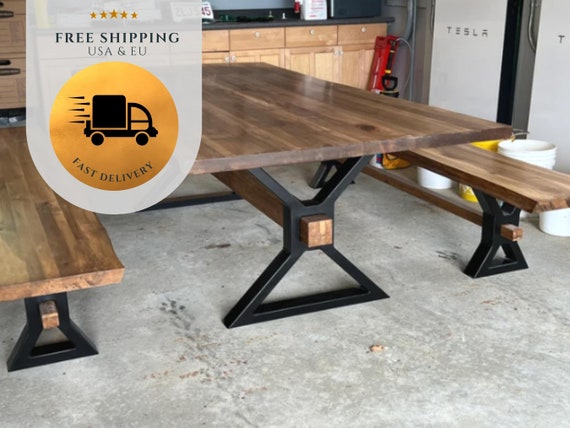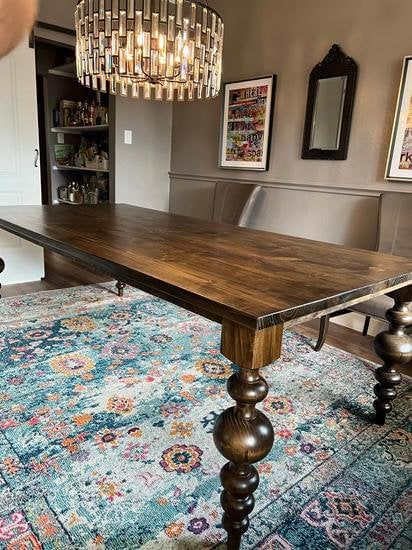Affordable and High-Quality Dining Room Table Legs for Every Budget
Affordable and High-Quality Dining Room Table Legs for Every Budget
Blog Article
From Typical to Modern: Discover the Ideal Dining Area Table Legs for Your Style
The choice of dining area table legs plays an essential role in defining the total personality of your room, connecting the space between standard craftsmanship and contemporary looks. While classic styles such as cabriole and transformed legs evoke a sense of classic refinement, contemporary designs like barrette and geometric options present a chance for striking visual rate of interest. Reviewing the ideal equilibrium between these designs requires a nuanced understanding of your existing design and personal taste. As you take into consideration these aspects, the concern continues to be: just how can you seamlessly incorporate these varied leg designs to produce a harmonious dining experience?
Understanding Table Leg Styles
The variety of eating room table leg designs can substantially affect both the visual appeals and performance of the space. Each leg design contributes distinct visual components and functional attributes, dealing with diverse design preferences and use demands. Recognizing these designs is important for picking the ideal table that lines up with your general indoor style vision.
For instance, conical legs use a tidy, traditional look that can improve a space's sophistication, while stand bases supply security and optimize legroom, making them suitable for smaller spaces. Hairpin legs, a hallmark of mid-century contemporary layout, introduce a commercial flair, permitting for a ventilated, open feel. Likewise, trestle legs evoke rustic charm, supplying robust support and a feeling of eternity.
Furthermore, the selection of products plays a substantial duty. Wooden legs can bring heat and appearance, whereas steel choices usually share a smooth, contemporary vibe. Eventually, understanding table leg styles is essential for creating a natural eating location that mirrors personal style while making sure functionality and comfort. By thoughtfully thinking about these aspects, you can enhance both the practical and aesthetic appeal of your dining space.
Standard Table Leg Options
When selecting eating room table legs, standard options typically personify ageless sophistication and workmanship. These layouts show an abundant heritage and a dedication to high quality, making them perfect for those who appreciate timeless visual appeals.
One of one of the most legendary conventional leg styles is the cabriole leg, characterized by its elegant bent shape. This style typically features attractive makings and is most generally discovered in Queen Anne and Chippendale furniture. One more preferred alternative is the turned leg, which flaunts a series of smooth, rounded shapes that offer a timeless look while maintaining stability.
Moreover, the straight leg, while basic, uses a sturdy and basic framework that can blend flawlessly with a variety of tabletop styles. For those drawn to ornate outlining, claw-and-ball feet legs evoke a feeling of grandeur and can offer as a spectacular focal point in any type of dining room.
Lastly, stand bases, although not purely legs, give an alternate typical alternative that permits sufficient legroom and can be perfectly sculpted. Each of these typical leg designs contributes to the general atmosphere of a dining you can look here room, marrying feature with aesthetic charm.

Modern Table Leg Designs
Modern table leg styles supply a diverse variety of designs that highlight tidy lines and ingenious materials. These styles commonly prioritize performance while serving as striking prime focus within a dining space. Minimalist aesthetics are common, with legs crafted from products such as steel, glass, and engineered wood, which add to a contemporary and airy feel.
One prominent design is the hairpin leg, identified by its slim, tapered framework that gives security without frustrating the table top (dining room table legs). This design is usually discovered in mid-century contemporary furnishings and can effortlessly match numerous eating table shapes. Another fad is making use of geometric forms, where legs might handle angular or asymmetrical forms, including aesthetic passion and a touch of creativity

Blending Designs for One-of-a-kind Areas
Commonly, property owners look for to develop one-of-a-kind dining rooms that show their personal style by blending different design aspects. This method enables for the incorporation of varied aesthetics, causing a harmonious yet distinct atmosphere. Pairing a rustic wooden table with streamlined, modern steel legs can create a captivating comparison that raises the area's total appeal.
Furthermore, incorporating vintage table legs with contemporary table tops can stimulate a sense of background while go to my site keeping a contemporary sensibility. Such mixes not only display individual taste but additionally urge creativity, enabling property owners to curate a space that feels both personal and inviting.
Shade plays an essential role in this mixing procedure; picking table legs that match or contrast with the existing color pattern can boost aesthetic passion. Whitewashed legs can soften the boldness of a dark table surface area, developing a balanced aesthetic.
Tips for Picking the Right Legs
Selecting the right table legs is essential for achieving both capability and visual appeal in your dining space. Begin by thinking about the overall design of your area. Typical setups take advantage of legs that include detailed carvings or transformed styles, while modern spaces may require sleek, minimal designs.
Following, analyze the height and security of the legs. dining room table legs. Conventional dining tables range in between 28 to 30 inches in elevation, so make certain the legs complement this dimension for comfort. Additionally, robust materials, such as hardwood or steel, can boost stability and longevity
Examine the leg form as well-- choices include right, tapered, or stand designs. Straight legs use a traditional look, while conical legs can include a touch of elegance. Pedestal bases give sufficient legroom and are optimal for smaller sized spaces.
Verdict
In summary, selecting the excellent dining area table legs requires cautious factor to consider of both modern and traditional styles. By integrating leg style, elevation, and material with the general décor, a natural and welcoming atmosphere can be achieved.
The variety of dining area table leg styles can dramatically affect both the looks and capability of the room. Eventually, comprehending table leg styles is vital for developing a natural dining location that shows individual design while making certain practicality and convenience.One of the most famous typical leg styles is the cabriole leg, identified by its graceful bent form. Straight legs use a timeless appearance, while conical legs can include a touch of style.In summary, picking the ideal dining room table legs requires careful factor to consider of both contemporary and standard styles.
Report this page